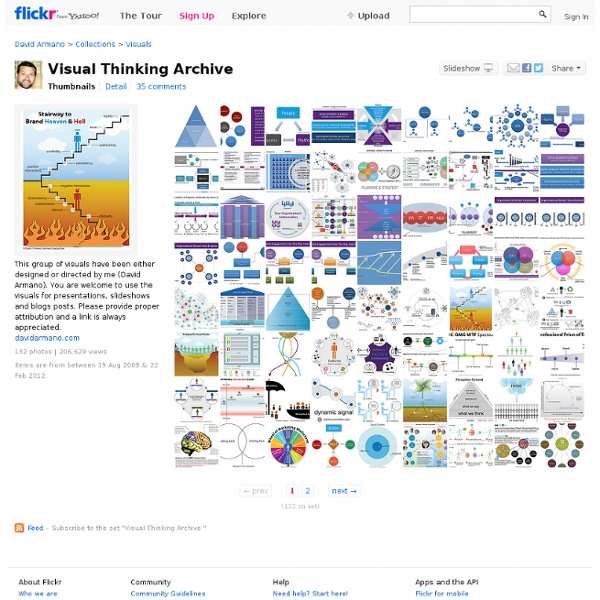



http://www.flickr.com/photos/7855449@N02/sets/72157606844282993/
Related: Design ThinkingDesign thinking Design thinking stands for design-specific cognitive activities that designers apply during the process of designing.[1] Overview[edit] Design thinking has come to be defined as combining empathy for the context of a problem, creativity in the generation of insights and solutions, and rationality in analyzing and fitting various solutions to the problem context.[2] According to Tim Brown, CEO and president of IDEO, the goal of Design Thinking is "matching people’s needs with what is technologically feasible and viable as a business strategy" [3] The premise of teaching Design Thinking is that by knowing about how designers approach problems and the methods which they use to ideate, select and execute solutions, individuals and businesses will be better able to improve their own problem solving processes and take innovation to a higher level. Origins of the term[edit] (For a detailed evolution, see History, below.) Solution-based thinking[edit]
50 Great Examples of Data Visualization Wrapping your brain around data online can be challenging, especially when dealing with huge volumes of information. And trying to find related content can also be difficult, depending on what data you’re looking for. But data visualizations can make all of that much easier, allowing you to see the concepts that you’re learning about in a more interesting, and often more useful manner. Below are 50 of the best data visualizations and tools for creating your own visualizations out there, covering everything from Digg activity to network connectivity to what’s currently happening on Twitter. Music, Movies and Other Media Narratives 2.0 visualizes music.
List of academic databases and search engines Wikipedia list article This article contains a representative list of notable databases and search engines useful in an academic setting for finding and accessing articles in academic journals, institutional repositories, archives, or other collections of scientific and other articles. Databases and search engines differ substantially in terms of coverage and retrieval qualities.[1] Users need to account for qualities and limitations of databases and search engines, especially those searching systematically for records such as in systematic reviews or meta-analyses.[2] As the distinction between a database and a search engine is unclear for these complex document retrieval systems, see: the general list of search engines for all-purpose search engines that can be used for academic purposesthe article about bibliographic databases for information about databases giving bibliographic information about finding books and journal articles.
Creator / Home - Online Lighting Diagram Creator - Tools for photographers Photography lighting diagrams made easy with this online tool: use the drop down menus, select objects, drag them, rotate them, change their layers then export your diagram to JPEG or save its URL. v3 beta is now public with iPad support, it includes ability to add notes. Select an image set and objet to add: Visual Thinking + Synthesis Photo by Ken Yeung I really enjoy talking complex subjects, processes or business problems and boiling them down to their core essence. This is becoming known as the process of "Visual Thinking". I use visual metaphors and storytelling to do this. My style of visual thinking is immediately recognizable and has helped me build a strong following of influential professionals who use my visuals in their own presentations and documents. A comprehensive archive of my visuals can be found on Flickr (please credit if you use them) and if you are interested in Visual Thinking as a discipline, you can visit VizThink for additional resources.
Rethinking Design Thinking Posted by Don Norman | 19 Mar 2013 | Comments (15) OK, I take it back. Well, some of it anyway. In June, 2010, I posted an essay on Core77 entitled "Design Thinking: A Useful Myth." (Got a lot of responses, that one did.) Since my essay was posted, I keep encountering people who jump to solutions and who fail to question assumptions—engineers, business people, and yes, designers (and design students).
Great Visualizers: Always With Honor Design duo Tyler Lang and Elsa Chaves are Always With Honor, an Portland-based design team with a specialty in beautifully simple information displays and iconography. I first got turned on to / by their work when I spotted this awesome poster. It visualizes the many domains within design. Somewhat awesomely. (Here’s a link to a massive hi-res version) What is the Meaning of Life What is the meaning of life? What is the purpose of life? Why are we here? Creative Business Card Designs Even the most creative business card design cannot guarantee your business success, however it is one of those very first things that make a very long lasting impression. So, make the best use of it, and never limit your imagination to a plain rectangle! Also, don’t forget to include some interactivity – people love to play and solve puzzles. If you happen to be designing a business card right now and need some business card inspiration, you’ve come to the right place – these 15 business card examples will definitely make your creative juices flowing! More creative business cards here
A Construct of Connectedness: The State of Community Management Our friends over at the Community Roundtable have done a wonderful job of summarizing key insights on the state of community management as it relates to the emerging development of social business. I was tapped to write this years Introduction to the report which is full of both breadth and depth of insights and information on the maturation of digital community building as a business strategy. The report is comprehensive and will take a while to absorb, but it also puts forth a tangible framework which outlines the maturation of managing communities: There are a ton of great takeaway from the report, but I found that a constant theme was the combination of both content (in the forms of aggregation, curation, and amplification) and engagement between community members and ambassadors for the organizations who help grow them as a constant storyline which re-emerged in different scenarios.